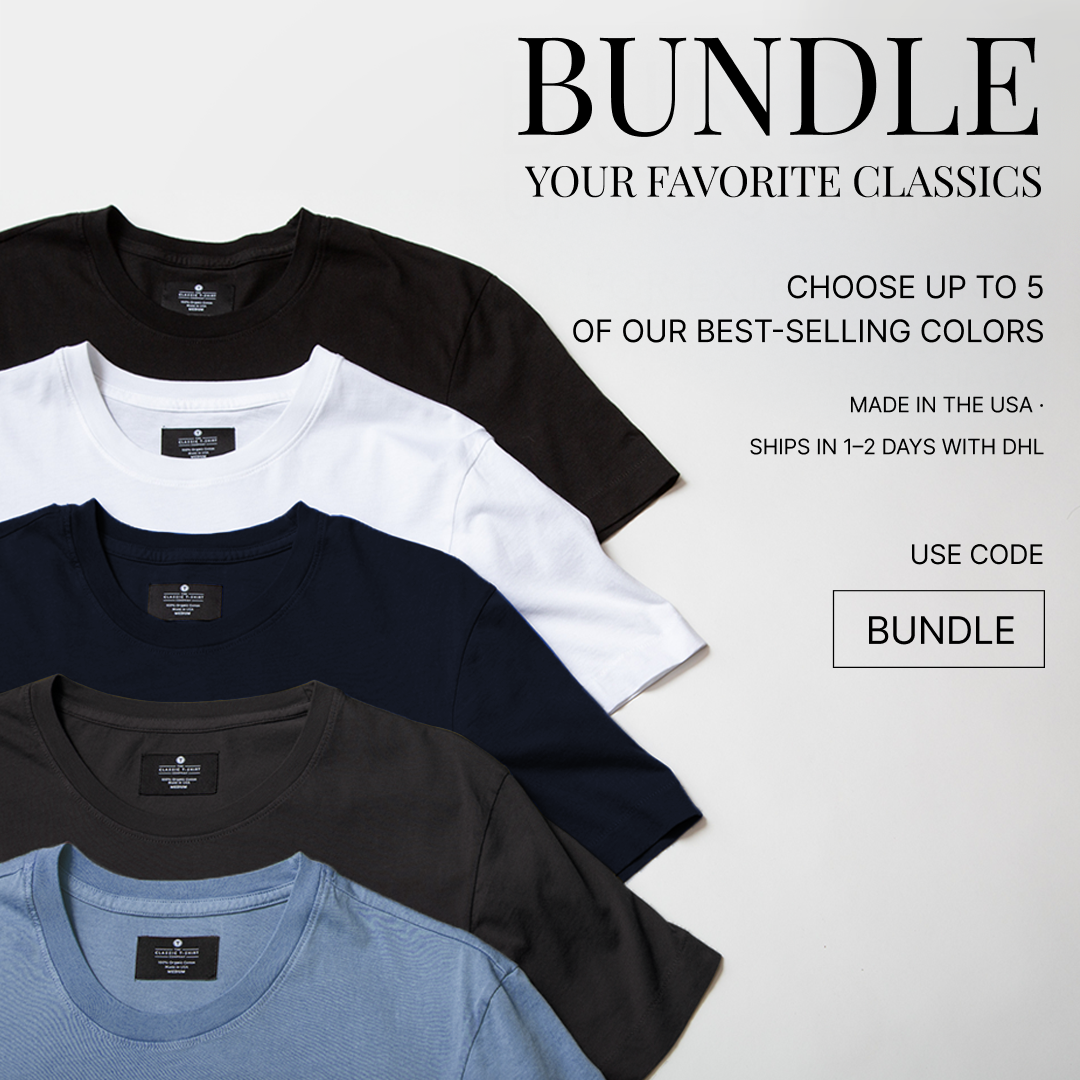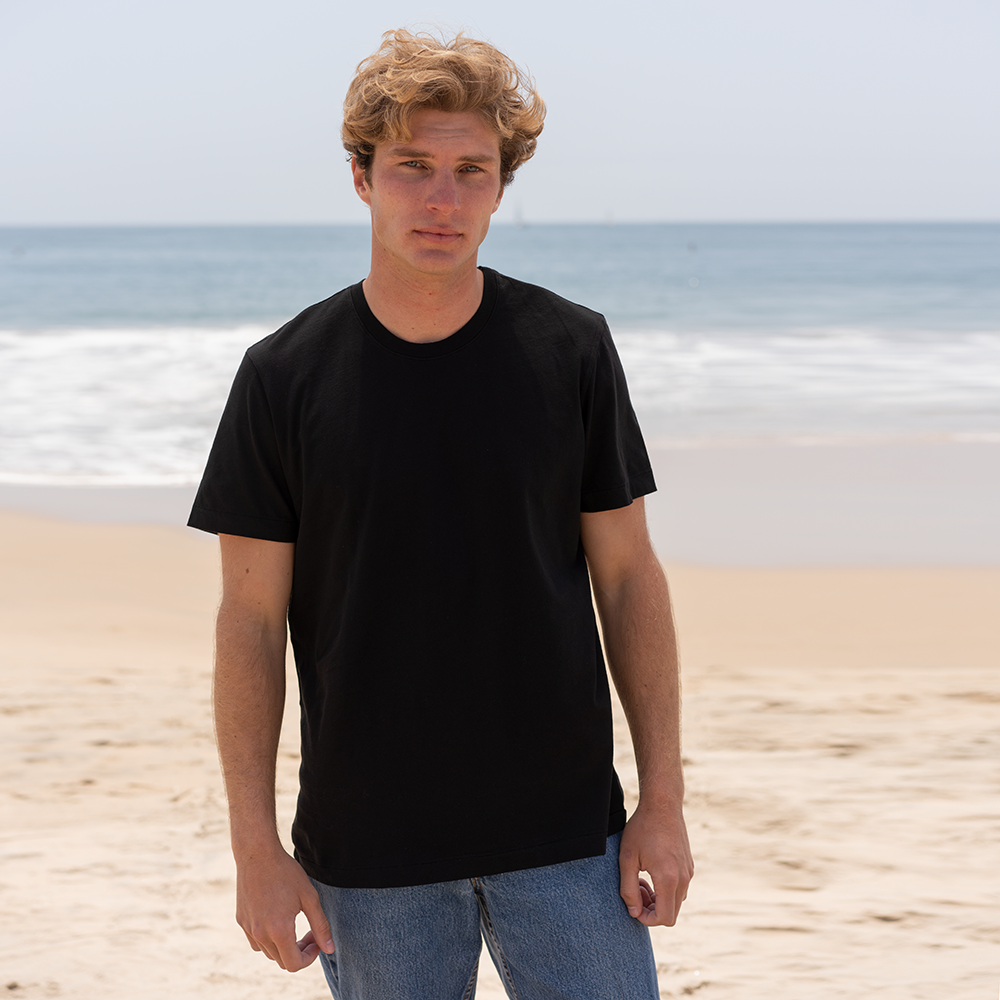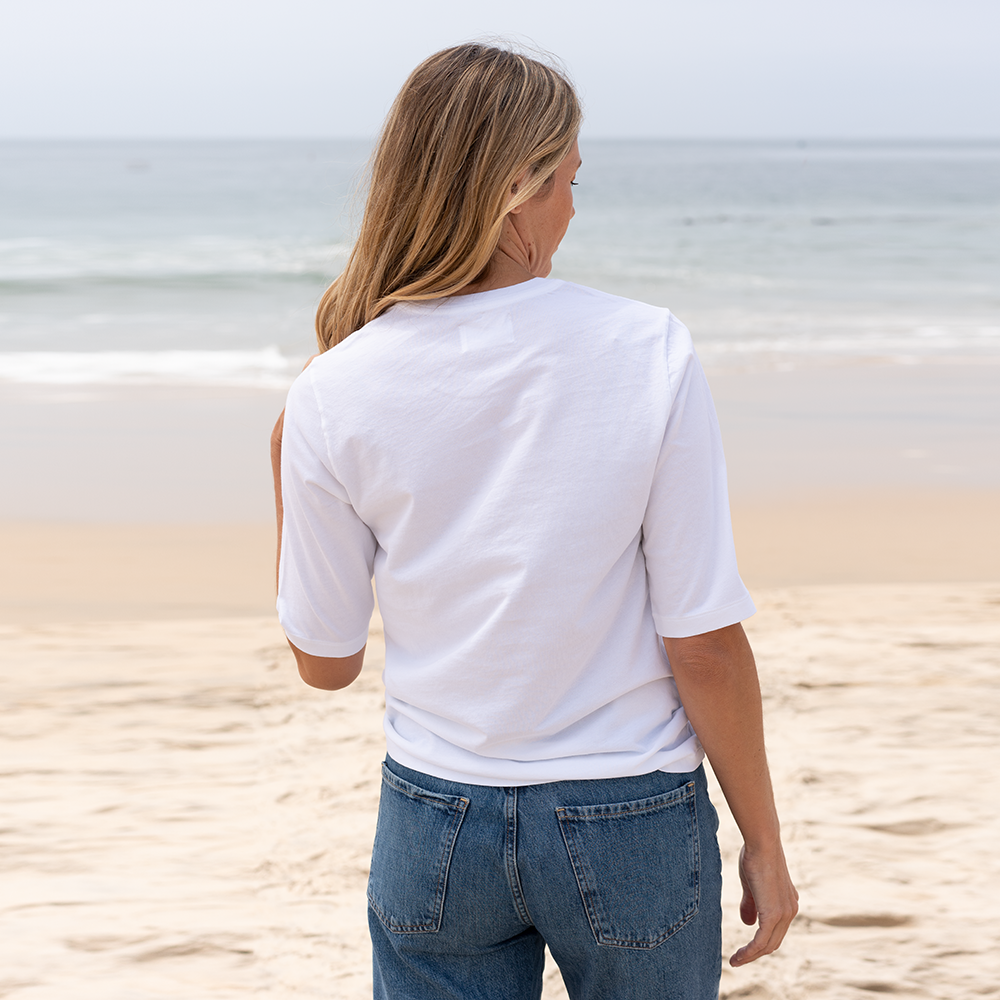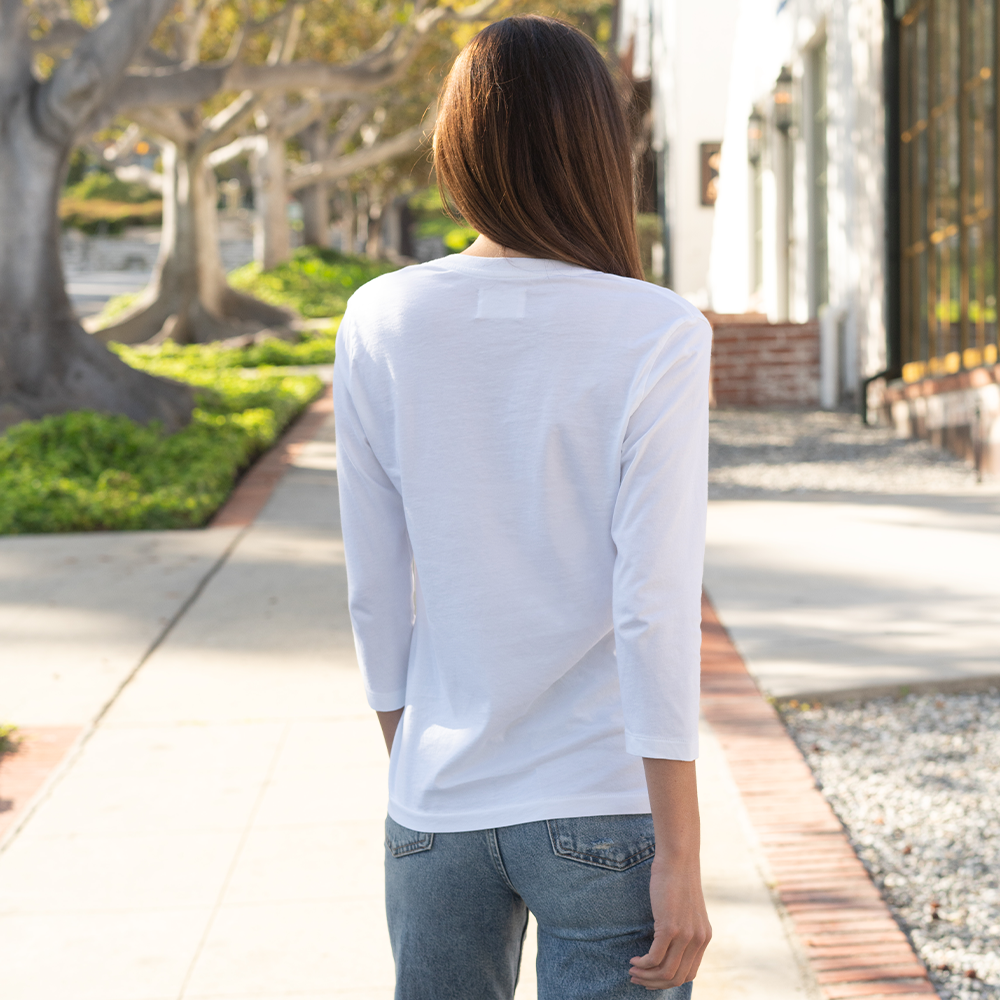
The Evolution of the Classic T-Shirt
The white T-shirt has been around for as long as we can remember. It’s just as much a staple to our wardrobes as blue jeans or socks.
But where did it come from?
Surprisingly, the most basic part of any outfit has an elaborate and impressive history. It (likely) began with a war, then moved to disrupting society, and has continued to evolve as a symbol of expression, rebellion, comfort, and luxury.
Who Thought up the Idea of a T-Shirt?
Nobody knows for sure if there is a single person who deserves credit for the concept of a T-shirt. It’s likely that people ripped up other clothing in order to make garments that today we might consider T-shirts. But generally speaking, clothing wasn’t designed the way it is today. Believe it or not, onesies were all the rage.
Before there were T-shirts, there were union suits. These were one-piece undergarments designed in the mid 1800s as an alternative to restrictive undergarments women had to wear in Victorian times.
The union suits featured buttons and flaps and were ultimately never popular among the elites, but in the late 1800s laborers adopted the outfit. Often made of wool flannel or heavy cotton, variants of union suits were popular in winter, and lighter cotton variants were often worn in summer--and believe it or not, wearing union suits on their own was the source of controversy. If you thought it was crazy that in the 1920s women showing their ankles was taboo for its time, wait until you see what the previous generations thought was scandalous.
According to the New York Times, “Lawmakers in Havana went so far as to ban the public display of any underwearlike top [for all genders], and so laborers had to toil in the heat wearing long-sleeve shirts with buttons.”
You may be wondering why people of the 1800s would wear such hot and restrictive clothing while working in the heat. Well, people in the 1800s were wondering the same thing.
That may well have been where the rebellious nature of T-shirts began. According to BBC, frustrated laborers began cutting their undergarments in half and tucking in the top half. This may have inspired sailors in the US navy stationed near Havana to do the same--or maybe those US sailors were the first to invent the style.
In any case, the Spanish-American war is often credited for starting the T-shirt revolution. Given most of the action took place in warm and humid climates of the Caribbean and South Pacific, it’s not hard to imagine sailors on both sides would have appreciated cooler and more comfortable undergarments.
It’s worth mentioning that in those days, everyone wore organic textiles, as plastic wasn’t invented until 1907. Typically those textiles were wool or cotton, the latter being a thicker fabric than what we would expect in modern clothing. This is one reason why many people wearing cotton undergarments in those days still suffered from how uncomfortable they were. Another reason is how the clothes were made.
Unlike modern T-shirts, undergarments of the time were custom-made to fit an individual person’s body. They were designed to fit tight against the skin so that you could wear clothing overtop, rather than to letting your body regulate its own temperature by letting air flow through the fabrics.
Today high quality cotton fabrics can make a huge difference in keeping you cool in the summer and warm in the winter thanks to air circulation. Read more about why cotton is so comfortable here.
T-Shirts Were Originally for Bachelors Who Couldn’t Sew
Shortly after the Spanish-American war, the Cooper Underwear Company famously ran an ad featuring “the bachelor shirt” in 1904.
As you can imagine, buttons on undergarments are pretty impractical and prone to tears. That might explain why Cooper Underwear Company advertised the T-shirt as a no-fuss undershirt that you could pull over your head. No need for needles or thread—the T-shirt was simple, easy, and comfortable.
Without the internet (or television) word was a bit slow to get out in those days, so the ad didn’t exactly go viral… but it’s possible that this ad directly inspired the Navy to adopt the T-shirt.
THE STANDARD ISSUE T-SHIRT
The US military began issuing what we would today call a T-shirt as early as 1913. Back then, they were called “lightweight short-sleeve white cotton undervests.” Soldiers working in warm climates would often shed their outer layers, wearing nothing but plain white T-shirts and embracing the look in civilian life. The T-shirt quickly became popular among all types of working men.
F. SCOTT FITZGERALD NAMED THE T-SHIRT
The T-shirt was given many names, like a “crew-neck shirt,” a “bachelor undershirt,” or a “cotton pullover.” But when F. Scott Fitzgerald first called it a T-shirt in his book This Side of Paradise, the name caught on. It made sense--the shape of the shirt looked like a “T.”
Teenagers Were the First to Wear T-Shirts Solo
Who else would be better at setting a rebellious trend? High schoolers started wearing T-shirts by themselves in the 1940s. Some would even add decorations like fringe or sew-on patches for style. It was a unique way for young people to express themselves, and the generations that followed would take the T-shirt even further past its imagined limits.

Photo: Wikimedia Commons
Marlon Brando Immortalizes the T-Shirt
Even with their new name, T-shirts primarily remained as undershirts until the 50s. But when Marlon Brando wore a white T-shirt in A Streetcar Named Desire, markets exploded with a demand for his look. The style was officially in for good.
It’s hard to say if it was Brando’s stardom or character that popularized the T-shirt, but either way, Hollywood was on to something. A few years later, A Rebel Without a Cause would rock the world with the legendary James Dean, who would end up taking the T-shirt further as a fashion statement by rocking it on and off the big screen.
Related: How James Dean Made the T-shirt a Classic Symbol of Cool.
Plain T-Shirts Were a Huge Political Statement
Even in the 1960s, the T-shirt was considered an undershirt, and it generally wasn’t considered “proper” to wear it as a standalone… except for maybe hanging out with friends. But the 60s generation was ready to challenge that along with many other notions. College students, protestors, and creatives often wore plain T-shirts to protests, decorating them with all kinds of messages and symbols.
But just wearing a plain T-shirt was a statement in itself: To hell with modesty, conformity, and the status quo. It was time to embrace authenticity and individuality.
T-SHIRTS ARE BECOMING THE FOUNDATION OF THE MINIMALIST WARDROBE MOVEMENT
In the interest of reducing waste and excess, many people are adopting minimalist and sustainable wardrobes starting with basic essentials like Classic T-shirts.
The art of curating a minimalist wardrobe is all about investing in clothing items that provide versatility and longevity, meaning you can use them for all sorts of outfits and they will last a long time.
T-shirts have become such an essential component to the minimalist wardrobe because like jeans, they can be paired with many different outfits for all sorts of functions. Also like jeans, the quality of T-shirts makes a stark difference in what sorts of functions you can wear them to. Generally speaking, the higher quality, the more acceptable it is to wear for a formal(ish) function.
Related: Classic T-shirts to Wear With Jeans
Timeless Wardrobe Staples Evolving Into Greatness
Green grass, blue jeans, white T-shirts. Few things can conjure the nostalgia of childhood quite so easily, and across so many generations. From Boomers to Gen-Z, the T-shirt has become such a lifestyle essential, it’s almost strange to think you’d ask someone if they wear T-shirts, but rather, what kind of T-shirts?
There are many types of T-shirts and feel free to check out our guides for men and women to learn all about them, but no matter what kind of T-shirt you’re wearing, it’s important that you feel good wearing it.
Whatever style of T-shirt you go with, always make sure:
- Your T-shirt is comfortable
- You feel stylish wearing your favorite T-shirt
- The production of your T-shirt should be helping rather than hurting the planet
- Your T-shirt should last a long time
Related: Reasons Why a Classic T-Shirt Will Be Your New Favorite Shirt
Maybe that’s too much to expect from a “regular” T-shirt… but luxury T-shirts and high quality T-shirts check most of those boxes.
Classic T-shirts check all of them.
SO WHAT IS A PREMIUM T-SHIRT? PREMIUM T-SHIRTS VS. REGULAR T-SHIRTS
Just as with anything, quality depends on how a T-shirt is sourced, sold, and made.
How it’s sourced?
It all starts with cotton. Like all living things, cotton plants need proper nourishment to grow healthy. But they don’t always get it. In fast fashion, cotton production is meant to cut financial expenses and maximize profits, which leads many companies to use fertilizers, chemicals, and pesticides that are extremely harmful to the environment.
Organic cotton isn’t grown with those chemicals. Instead, it’s grown with organic fertilizer which helps the plants grow as nature intended them to. By letting plants grow healthy and strong, organic cotton producers are able to create better quality fabrics and use less resources.
Read more about organic cotton here.
How it’s made?
Every Classic T-shirt is proudly made in Los Angeles, California. While the labor to produce T-shirts in the United States is usually more expensive than other countries where other T-shirts are being made, it’s important to us that everyone involved in the process gets paid a fair wage. It’s not a question of whether or not we can afford to make that happen--it’s a question of how we are going to make that happen.
So far, we’ve made it happen thanks to our customers. Thanks to those who have been willing to give Classic T-shirts a try, and those who help share their thoughts as to why it’s worth the investment.
How it’s sold?
Many T-shirts are made in bulk, sold in bulk, and wasted in bulk. Not only is this part of what makes the fashion industry one of the world’s largest polluters, it’s not good for consumers to keep buying and replacing their T-shirts rather than investing in high quality T-shirts that will last a long time.
The Classic T-shirt Company is trying to change that by focusing on quality over quantity. We don’t produce as many T-shirts so that the environment can easily recover from any impact our production makes. We don’t participate in seasonal sales because those are awful for the environment. And we are 100% transparent about what goes into the cost of making a Classic T-shirt, from sourcing organic cotton to getting the word out with our marketing.
Our goal with marketing is to help you make informed decisions. If you choose to buy regular T-shirts and remain in the fast fashion cycle, we just want you to be aware of the impact that will have on the planet and your life. On the other hand, if you choose to invest in a sustainable fashion brand like the Classic T-shirt Company, we want you to know the positive impact that has on the planet and your lifestyle.
We’re not just selling sustainable luxury T-shirts. We are investing in the sustainable fashion movement together as a company and as consumers.
Plastic-free shipping is icing on the cake.
Related: Premium T-Shirts — Back to Basics
Make a statement With Your Classic T-shirt
Today, sustainable fashion and Classic T-shirts are taking off in popularity. They are the staple for the fashion-forward, conscious consumers, and savvy investors.
It’s thanks to the luxury T-shirt movement that we are seeing T-shirts as a go-to for casual and workwear--we’re even seeing T-shirts as acceptable for business casual wear in the workplace, and as a great piece to wear with suits.
A Classic T-shirt doesn’t need a message printed on it--the quality speaks for itself. When you wear a Classic T-shirt you are making a statement in that you are committed to supporting the sustainable fashion movement, you are committed to wearing quality.
Join the movement of ethical T-shirts by shopping our Women’s Premium T-Shirts or our Men’s Premium T-Shirts.
































